
Section 15. Global Risks 2021
This Section presents key global risks and foreign policy trends according to the versions of several analytical centers, namely the analysts of the World Economic Forum, the consulting company Eurasia Group, and the Laboratory of International Processes Analysis at the Moscow State Institute of International Relations of the Ministry of Foreign Affairs of Russia (MFA Russia MGIMO).
Risks 2021 (World Economic Forum)
"The 2021 report reflects the depth and disparity of the pandemic’s impact, explores how critical global challenges have been exacerbated and reshaped, and highlights the need to address these risks in a more collaborative way."
Carolina Klint, Managing Director, Risk Management Leader Continental Europe, Marsh
COVID-19 is exacerbating ongoing geopolitical and societal challenges, and the existential crisis of climate change looms large. More innovative and collaborative approaches to resilience are needed more than ever.
Global Risks 2021: Fractured Future
The emerging risks landscape
The Digital Divide. Biased algorithms, lack of access to information, widening digital skills gaps, and inadequate regulation are exacerbating societal inequalities. If left unaddressed, this will further erode already-fraying societal cohesion. Businesses and governments need to seek new partnerships and approaches to drive digital cohesion without compromising technological advancement.
Generation Pandemic. Youth, already suffering from long-standing intergenerational inequalities, were severely impacted by COVID-19. Impacts to education, migration, and mental health will further harm this generation’s outlook. Avoiding a future of deep societal fracturing requires their voices to be heard and be actively involved in the pandemic recovery process.
Navigating Global Fractures. Deepening rivalries and competition in various domains between superpowers could impede the influence of other G20 nations in international relations and further splinter geopolitics. Such developments could destabilize the global order and slow critical progress on transnational concerns.
A Trilemma of Pressures on Industry. The growing power and influence of nation states, market concentration in the technology sector, and values-driven pressure from consumers, employees, and society at large present complex challenges for industry globally. They need to consider strategy and investments during their COVID-19 recovery to avoid catastrophic outcomes.
2020 Hindsight: Reflecting on Resilience. The COVID-19 crisis has exposed fundamental disconnects between assumptions of global and national pandemic preparedness and the realities of crisis management on the ground. Remarkable examples of determination, cooperation, and innovation have surfaced, particularly with collaboration between the public and private sector, but very few nations have shone across all aspects of their response effort. There are many lessons to be learned to improve our collective management of global risks.
Climate continues to be a looming risk as global cooperation weakens. Climate change—to which no one is immune—continues to be a catastrophic risk. Although lockdowns worldwide caused global emissions to fall in the first half of 2020, evidence from the 2008-2009 Financial Crisis warns that emissions could bounce back. A shift towards greener economies cannot be delayed until the shocks of the pandemic subside.
No vaccine for environmental degradation. Last year, for the first time in 15 years of the Global Risks Perception Survey (GRPS), the five most likely long-term risks were environmental— analyzed in last year’s Global Risks Report chapters. The WEF COVID-19 Risks Outlook, published in May 2020, analyzed how the crisis could stall progress on climate action. This year, GRPS respondents ranked environmental risks as four of the top five by likelihood—“infectious diseases” is fourth. Global CO2 emissions fell by 9% in the first half of 2020, when COVID-19 forced most economies to shut down for weeks. A similar decrease is required every year for the next decade to maintain progress towards limiting global warming to 1.5°C (see Figure below) and avoid the worst effects of climate change. Collective efforts are needed to prevent a repeat as economies emerge from the pandemic. Growth and emissions must be decoupled and transition risks managed in an urgent evolution to a low-carbon economy. At present, only four of the world’s largest economies have assembled recovery packages that will produce a net environmental benefit.
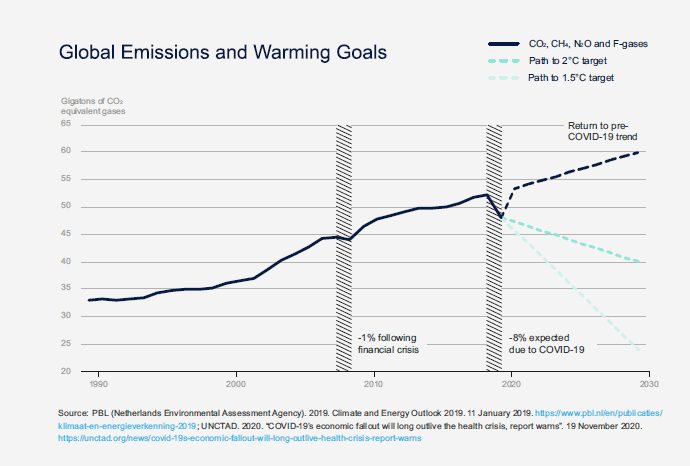
Risk outlook: Failure to act looms large in 2021. A failure to act on climate change dominates the risk landscape in 2021 as the world gets ready for a delayed COP26. Like 2020, environmental risks rank highly in consequence and likelihood, with infectious disease and its ripple effect on employment and livelihood high on the risk landscape. This year respondents also highlighted areas of opportunities to act and mitigate potentially dire consequences.
Clear and present dangers (0-2 years) reveal concern about lives and livelihoods – among them infectious diseases, employment crises, digital inequality and youth disillusionment. In the medium-term (3-5 years), respondents believe the world will be threatened by knock-on economic and technological risks, which may take several years to materialize – such as asset bubble bursts, IT infrastructure breakdown, price instability and debt crises. Existential threats (5-10 years) – weapons of mass destruction, state collapse, biodiversity loss and adverse technological advances – dominate long-term concerns:
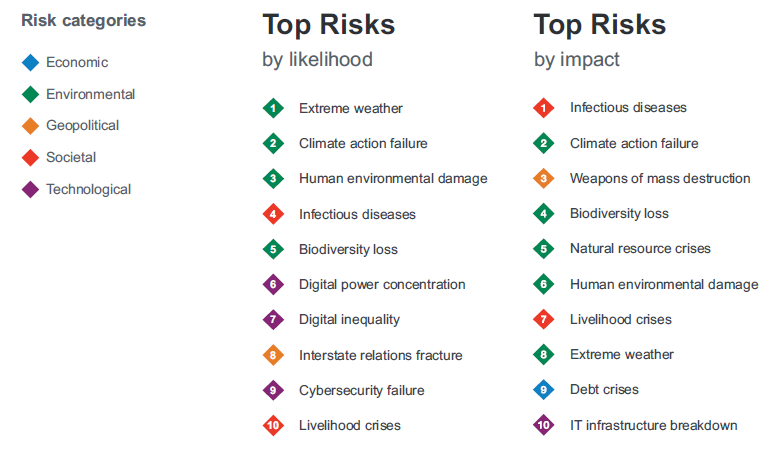
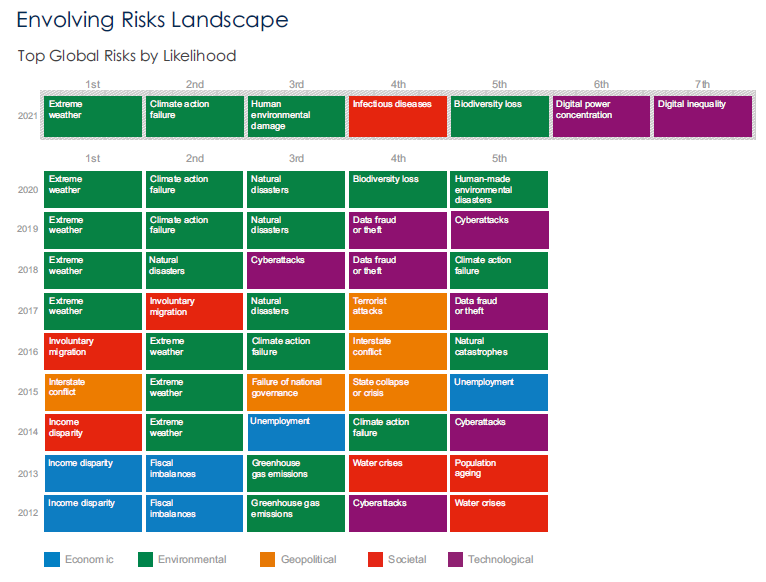
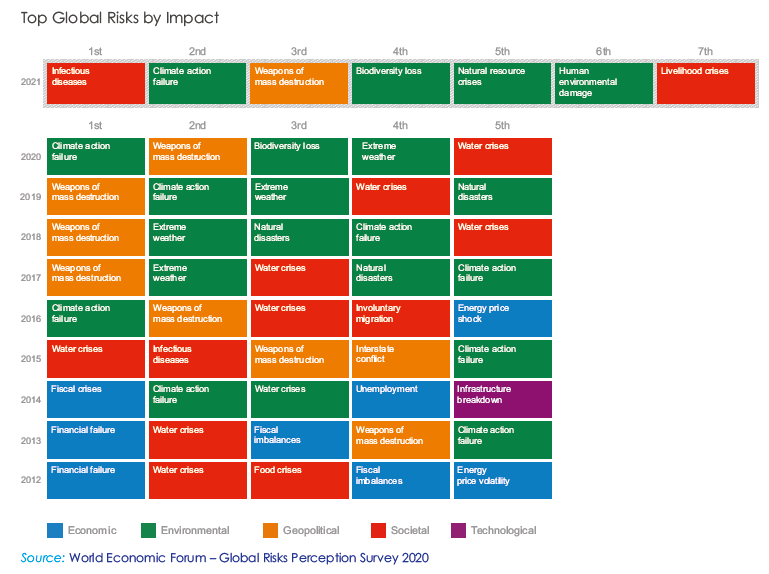
The report also reflects on the responses to COVID-19, drawing lessons designed to bolster global resilience. These lessons include formulating analytical frameworks, fostering risk champions, building trust through clear and consistent communication, and creating new forms of partnership. The key risks outlined in the report are complemented with recommendations to help countries, businesses, and the international community to act, rather than react, in the face of cross-cutting risks. The report closes with an overview of “frontier risks” – nine high-impact, low-probability events drawn from expert foresight exercises – including geomagnetic disruption, accidental wars and exploitation of brain-machine interfaces.
The Global Risks Report 2020 is available on
Risks 2021 (“Eurasia Group”)
The consulting company “Eurasia Group” presented its rating of ten global risks for 2021.
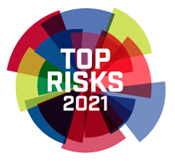
1. 46* or “Divided America” — a situation, in which about half of the U.S. population will consider every new leader of the country illegitimate. According to experts, this situation has developed with the accession to power of President-elect Joe Biden and President Trump's refusal to accept the outcome of an election.
2. Long COVID. Neither the coronavirus nor its wide-ranging impacts will disappear once widespread vaccination begins. Vaccination will further divide society into rich and poor, leading to social unrest in many countries. The pandemic will also result in job losses, loss of confidence in government, debt crises in the developing countries.
3. Climate change. Analysts consider the US’s return to the Paris agreement and commitments of the world's largest economy to net-zero emissions by 2050 as a step toward a new era of global cooperation and the triumph of net zero over G-Zero. However, climate change fight and energy transformation will take place in the face of fierce competition and lack of coordination.
G-Zero concept implies power vacuum in international politics as no country or group of countries has the political and economic leverage to drive an international agenda or provide global public goods
4. US-China tensions broaden. US efforts to enlist allies, vaccine diplomacy, and climate tech competition will further complicate US-China relations.
5. The global data reckoning starts with strategic competition between the US and China but doesn't end there. Other governments concerned about who is accessing their citizens' data—and how—are disrupting the foundations of an open global internet.
6. Cyber tipping point. More vulnerable devices, absence of effective diplomacy, and greater emphasis on cyber responses mean the unstable status quo in cyberspace will be tough to maintain in 2021.
7. Economic problems in Turkey may lead to political consequences.
8. The downturn in Middle Eastern economies due to low oil prices.
9. urope after Angela Merkel’s resignation.
10. Political and social crises in Latin Americaе because of the pandemic and elections in some countries.
Eurasia Group's Top Risks Report for 2021 is available on
Risks 2021 (MFA Russia MGIMO)
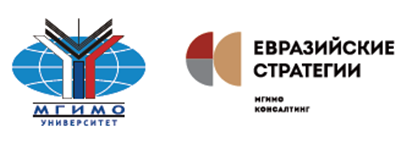
1. “More state” is the leitmotif of 2021». This is a direct consequence of the coronavirus pandemic. It is from the states that citizens expect effective protective measures and guarantees against economic losses. The pandemic does not make states weaker. However, their unconvincing and inadequate response to the threat gives the impression of weakness to friends, enemies and, perhaps most importantly, to their own citizens. Such scenarios of “state fiasco” will be repeated in the future.
2. The US stalls. In 2021, the US will almost certainly be unable to decide on a long-term foreign policy course, and this will be a year of dispelled illusions. The combination of factors, which are at the root of the current domestic political crisis and divide the country into two irreconcilable camps, has been building up over the past forty years, and who knows in what perspective their effect can be weakened.
3. “Green invasion” of Germany: technology without power. In 2019, EU adopted the Green Deal, which set a strategic goal of making Europe a climate-neutral continent by 2050. Germany, as the main mover and beneficiary of European integration, counts on new green economy, where it will set its own rules by right of a pioneer and technological leader. German business will dominate by taking over most of the production standards.
4. China is collecting its strength. In the documents of the fifth plenum of the CPC Central Committee, which defined the guidelines for China's development until 2035, the word “security” appears more often than “openness” or “innovation”. It is the interests of sustainability and security of the political system that will be the constraint dictating new external modesty and determining strategic priorities of internal development.
5. Strategic dilemmas of digital development. In 2021, the gap will continue to grow between independent platforms-providers of global technology and recipient countries gradually becoming dependent on technologically advanced states. “Digital colonialists” offer preferential terms for the creation of necessary infrastructure to transit to digital future, thus ensuring reliance on their solutions.
6. The danger of “sanctions bubbles”. The rapid spread of secondary sanctions lays the ground for a fundamentally new phenomenon of “sanctions bubbles”, where the gap grows sharply between a company's actual operating activities and the sanctions risks associated with them.
7. Turkey's “brilliant bluff”: power without technology. The last year events, when Turkey directly or indirectly intervened in the conflicts in Syria, Nagorno-Karabakh, Libya and the eastern Mediterranean Sea, convince us that Turkey's course is much more twisted than any of its partners may assume. One of the threats is further increase in Turkey's expansion.
8. Climate migration in Africa. Climate migration is becoming a reality on the African continent, which in the last decade has recorded the highest average temperatures ever recorded. The World Bank estimates that by 2050 the number of climate migrants within states or to neighboring states may reach 70 million in sub-Saharan Africa at business as usual. Some 15-25 million of these migrants and victims of climate conflicts may go to EU and the Arabian Peninsula.
9. Vaccine as a geopolitical marker. The events of 2020 gave rise to the term “infodemia”. The pandemic appeared to be firmly tied to the digitalization of citizens’ lives. In 2021, we are likely to see the strongest states increasingly dominate the IT market and, in turn, the biggest IT players increase their influence on the weakest states.
“International Threats 2021: Geopolitics after Pandemic” Report is available on